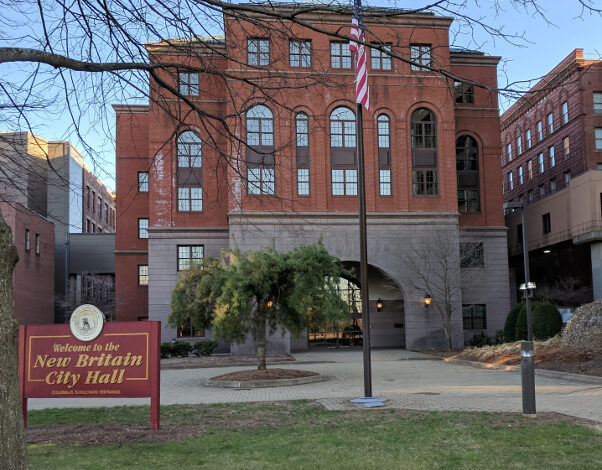The Selling Of Patton Brook Well: Will New Britain Get A Fair Price To Help Southington Address Its Water Crisis?
—–
Mayor Stewart’s Lowered $1 Million Price Drastically Undervalues Patton Brook Well
—–
By John McNamara
Contributing Columnist
A Monday, July 11th public hearing at New Britain City Hall will take up a proposed sale of the city’s Patton Brook Well in Southington as that town’s water commission faces growing challenges to address its need for water in the sprawling suburban community of 42,000.
The sale of the well — part of New Britain’s extensive and coveted regional water assets — would be an unprecedented and controversial move, breaking with longstanding policy of leasing water rights to Southington and others in the region, but retaining city ownership for the long-term.
Hearing Notice near Patton Brook Well. Photo used with permission: Bryan Lipiner/Record-Journal.
In 2014 Erin Stewart unsuccessfully pushed selling Patton Brook Well to Southington for a $1.2 million price saying that the well didn’t figure in the city’s water reserve plan. Southington’s Board of Water Commissioners would then pursue repair of the Patton Brook pumping station for the town’s exclusive use. Previously, New Britain had leased the well to Southington for $107,000 a year, an arrangement that lasted for more than 30 years.
The 2014 Common Council narrowly rejected that 2014 sale siding with city residents who wanted to preserve the well as part of New Britain’s regional water resources.
The Stewart administration, with the 2016 Council more favorable to her policies, is back. The asking price now, however, is inexplicably lower, $200,000 less than Southington’s $1.2 million offer in 2014.
How the Stewart Administration arrived at or agreed to the lower $1 million price should be a question on the minds of residents and the Common Council. By all accounts the Patton Brook Well is a prodigious water supply and a source within Southington’s borders that the town’s water commission badly needs to bring on-line.
Southington’s Water Department, for example, has imposed voluntary restrictions, “In order to conserve water supply during the unusual warm weather conditions and lack of rain fall,” according to the town’s website. Southington’s system is comprised of three reservoirs and seven wells which in their present condition cannot keep up with either residential or commercial development in town. According to New Britain resident William Ostapchuk’s research on Southington and New Britain’s water resources, three of the town’s wells have long been dormant because of pollution. “Wells 4,5 and 6 are not used because the drinking water provided by each was exposed to contamination by toxic pollutants from two sites, a landfill and Solvents Recovery of New England.” Ostapchuk found. “Both became Superfund cleanup sites.” Southington’s contamination problems led to the original leasing of the Patton Brook Well from New Britain decades ago.
The Town of Southington, in a December 2014 proposal from the water commission chairman to the U.S. Army Corps of Engineers, stated that the town “is struggling to provide current and future water supply, and will not be able to provide water to its 42,000 residents and businesses unless the community can address contamination in its present water supply, and establish sustainable, expanded water supplies for the future.” The December 2014 request to the Army Corps of Engineers sought an additional $7 million in funds to augment the $9.42 million already authorized by Congress for water improvements in Southington. The additional project costs include $1.5 million for Patton Brook predicated on Southington’s purchase from New Britain.
The real value of Patton Brook Well – whether it is to be leased or sold – should be calculated on its capacity to produce potable water for residents and businesses. At no time have New Britain officials, including Stewart and Water Services Director and Southington resident Gil Bligh, provided a professional or independent appraisal of the Patton Brook Well’s actual value in setting a sale price of $1.2 million two years ago and $1 million this year. Basing a sale or lease on a real property assessment of the pumping station and the small amount of acreage alone is absurd and irresponsible.
Patton Brook, according to official estimates, is capable of holding and providing 1.2 million gallons a day from its deep well. That kind of volume suggests that the proposed sale price of $1 million shorts New Britain out of a fair and reasonable deal by a big margin. Current water rates in Connecticut towns served by other regional water authorities provide a financial yardstick to determine whether the proposed $1 million deal between New Britain and Southington accurately reflects the well’s value. Patton Brook can pump 1.2 million gallons per day or 438 million gallons a year so long as water levels remain stable. Using Metropolitan District Commission (MDC) rates in towns served by MDC ($2.53 per 100 cubic feet or 748 gallons) Patton Brook would generate $1.48 million in user fees on an annual basis. Applying the residential rate of Connecticut Water that serves 56 communities in the state ($5.91 per 100 cubic feet or 748 gallons), user fees would total $3.4 million for water going into homes and businesses from Patton Brook.
There is no question that New Britain’s water supply is a resource that needs to be shared on a regional basis. And Patton Brook, either leased or sold, is the best vehicle to address Southington’s deteriorating and inadequate water system. But the situation also requires that New Britain officials, who serve a financially distressed and over taxed city of 72,000, obtain a fair price to address its own short- and long-term water needs. The $1 million sale price is neither fair nor reasonable given what Erin Stewart is proposing to irrevocably give up at a lower price that does not represent Patton Brook’s actual worth.
This article was originally published on NBPoliticus




